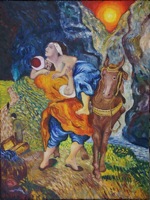Samaritans
Origin
Middle English, from Old English, from Late Latin samaritanus, noun & adjective, from Greek samaritēs inhabitant of Samaria, from Samari
Definitions
- 1: a native or inhabitant of Samaria
- 2: [from the parable of the good Samaritan in Luke 10:30–37 : a person who is generous in helping those in distress
Description
The Samaritans (Hebrew: שומרונים Shomronim, Arabic: السامريون as-Sāmariyyūn) are an ethnoreligious group of the Levant. Religiously, they are the adherents to Samaritanism, an Abrahamic religion closely related to Judaism. Based on the Samaritan Torah, Samaritans claim their worship is the true religion of the ancient Israelites prior to the Babylonian Exile, preserved by those who remained in the Land of Israel, as opposed to Judaism, which they assert is a related but altered and amended religion brought back by the exiled returnees.
Ancestrally, they claim descent from a group of Israelite inhabitants from the tribes of Joseph and Levi (another Benjamin tribe branch), who have connections to ancient Samaria from the beginning of the Babylonian Exile up to the Samaritan Kingdom of Baba Rabba. The Samaritans, however, derive their name not from this geographical designation, but rather from the Hebrew term Shamerim שַמֶרִים, "Keepers [of the Law]".
In the Talmud, a central post-exilic religious text of Judaism, their claim of ancestral origin is disputed, and in those texts they are called Cutheans (Hebrew: כותים, Kuthim), allegedly from the ancient city of Cuthah (Kutha), geographically located in what is today Iraq. Modern genetics has suggested some truth to both the claims of the Samaritans and Jewish accounts in the Talmud.
Although historically they were a large community — up to more than a million in late Roman times, then gradually reduced to several tens of thousands up to a few centuries ago — their unprecedented demographic shrinkage has been a result of various historical events, including most notably the bloody repression of the Third Samaritan Revolt (529 AD) against the Byzantine Christian rulers and the mass conversion to Islam in the Early Muslim period of Palestine. According to their tally, as of November 1, 2007, there were 712 Samaritans living almost exclusively in two localities, one in Kiryat Luza on Mount Gerizim near the city of Nablus in the West Bank, and the other in the Israeli city of Holon. There are, however, followers of various backgrounds adhering to Samaritan traditions outside of Israel especially in the United States.
With the revival of Hebrew as a spoken language by Jewish immigrants to Israel, and its growth and officialization following the establishment of the state, most Samaritans today speak Modern Hebrew, especially in Israel. As with their counterpart Muslim, Christian, Druze and other Israeli religious communities, the most recent spoken mother tongue of the Samaritans was Arabic, and it still is for those in the West Bank city of Nablus. For liturgical purposes, Samaritan Hebrew, Samaritan Aramaic, and Samaritan Arabic are used, all of which are written in the Samaritan alphabet, a variant of the Old Hebrew alphabet, distinct from the so-called square script "Hebrew alphabet" of Jews and Judaism, which is a stylized form of the Aramaic alphabet. Hebrew, and later Aramaic, were languages in use by the Israelites of Judea prior to the Roman exile, and beyond.[1]
